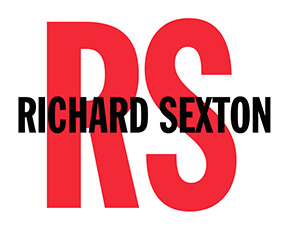Richard Sexton on his handmade art book, The Highway of Temptation & Redemption: A Gothic Travelogue in Two Dimensions:
1. Does the highway itself have any special significance in the book?
2. What is the significance of the design and the different types of paper that are used?
3. What types of books inspired the design for this book?
6. Tell us about your choices for the dedication.
7. What is the market for this book?
Does the highway itself have any special significance in the book?
The highway is a symbol for life. You start at the beginning, end up at a destination and along the way you encounter unanticipated things. There are crossroads. You can take a wrong turn or maybe you want to experiment because you’re just sightseeing or maybe you’re lost. When you turn here or there, your life ends up in a different place. The experience of highway travel is the perfect metaphor for life.
What is the significance of the design and the different types of paper that are used?
The text is printed on a translucent vellum sheet. The photos are printed on an opaque rag stock, with a slight tooth, similar to watercolor paper. Throughout the body of the book, the photos are placed on the dominant right page and the text is placed on the left page. I feel that writing is more abstract and ephemeral. But, particularly, it’s more subjective, more interpretive. I used the translucence of the vellum page to reinforce that. Photography, on the other hand, is more concrete and real, matter of fact. But, most importantly, a photograph is evidence of an encounter–the recordation of a subject that the photographer stared in the face. Because we know this intuitively, when we look at the photograph, the subject engages us because we know it’s real. The heavier, opaque stock, and dominant right-facing page reinforces this aspect of the photograph.
What types of books inspired the design for this book?
The design of the book is inspired by travel journals, diaries, and bibles. The red silk ribbon marker is a very biblical reference, though it’s equally valuable for travel journals and diaries. My intent was that readers would use it to mark their favorite road sign or comment, so they could come back to it easily, or give it some special significance.
How is the book organized?
It’s divided into 3 sections: prologue, travelogue, and epilogue. It’s meant to be read front to back like a work of literary fiction. If you try to digest it in pieces, you miss references and disjoint the storyline. When readers see a book with pictures in it, they always begin by looking at the pictures, usually in a random order. It’s difficult to get the reader to sit down and begin on page one. I tried to use the layout to enforce the idea that the book should be read through from front to back.
What about the typeface?
The text is set in a funky typewriter font. It’s actually a postscript font that was derived from a well-worn Olympia manual typewriter. So the text appears to be hand typed. I chose this typeface so that the text would look like an original, unpublished manuscript. Also, this typeface doesn’t look very polished—a characteristic of the road signs in the photographs. So, the road signs and the funky typewriter font seemed appropriate for each other.
Tell us about your choices for the dedication.
The book is dedicated to Ambrose Bierce, Walker Evans, and Ed Ruscha because they are the 3 individuals–a writer, a photographer, and a conceptual artist—that influenced me most dramatically regarding how I should approach this work. Interestingly, the timeframe of the careers of these three all overlap slightly and begin in the Victorian period and continue to the present. Also, their work is as profoundly influential today as in their own time. This also applies to Ruscha, who would be considered contemporary. His career began 4 decades ago in the early 60s and today it’s just as significant. There is another common bond between these three artists (for lack of a better word). They all had commercial careers or aspirations of them. Bierce was a journalist and newspaper editor. Evans was a photojournalist and magazine photo editor. Ruscha went to CalArts intending to become a commercial illustrator. His career as a conceptual artist, greatly influenced by signage and advertising slogans, took hold before he could manage to establish himself as an illustrator. (Some people are just lucky.)
What is the market for this book?
It’s difficult to know the market. It’s like trying to sell a $20 apple. Because the book is handmade, illustrated with original art, and printed on very expensive paper, the cost of the end product is very high when compared to trade books and other printed matter that’s mass marketed. The cost is very reasonable if the comparison is to an art purchase. In fact, it’s a steal on those terms. So, this is the crack into which this project falls—a quite expensive book or an extraordinarily cheap work of art. My gamble is that within this precarious strata of placement are 100 souls with a sense of irony and adventure.
